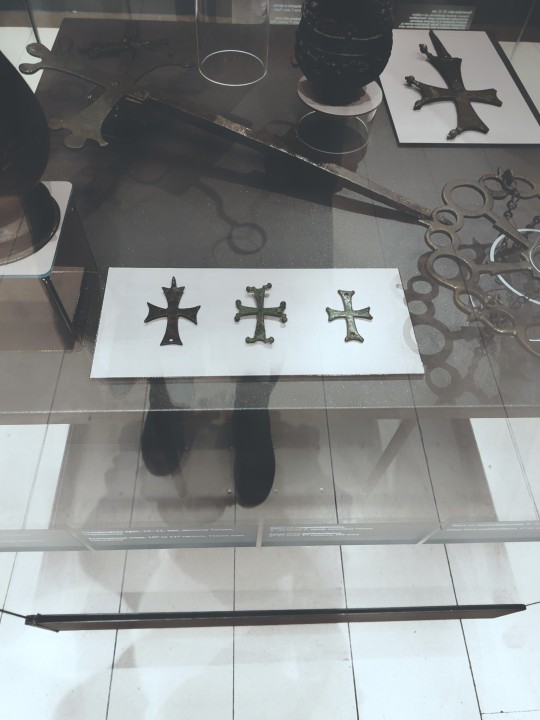#serbia national museum stuff
Text
So! As promised, here are some pics from the museum I visited today! The pics are from the Sarajevo 1878-1918 museum. The museum highlights the important moments of the Austro-Hungarian period in Bosnia and Herzegovina. From the occupation in 1878, annexation in 1908, to the Sarajevo assassination (the one where Framz Ferdinand and has wife Sophie were killed in) in 1914:
Picture 1: The territory of the Austro-Hungarian empire before it was dissolved in 1918
Picture 2: Symbols of Sarajevo at the time.
Picture 3: It shows some of the furniture the upper classes of Bosnia and Herzegovina started using after the administration to my country was placed on the Austro-Hungarian empire. My country was in the Ottoman empire for over 400 years, and a lot of people had so called Turkish styled homes, which were big and heavy furniture. When the Austro-Hungarian empire came, so the the westernized furniture come. Some people combined the two styles even.
Picture 4:This is the official declaration on the annexation of Bosnia and Herzegovina, which was signed by the then king Franz Joseph I (Franjo in Bosnian). Fun fact, the annexation wasn't taken lightly by the neighboring countries, especially with Serbia and the then Ottoman empire. Bosnia and Herzegovina was initially only given to A.U. for an undisclosed amount of time and would eventually be returned to the Ottoman empire (per agreement on the Treaty of Berlin). But, with the annexation, the territory was forcefully and officially taken away. This caused a lot of tension with the Russian empire as well, since the nation was an alley to Serbia and the empire had its own plans for the Balkan peninsula, which were now shattered by the annexation. This act helped lay out the grounds for WWI. In history books, it's referred to as The Bosnian crisis.
Picture 5: It's basically the wax figures of Archduke Franz Ferdinand and Duchess Sophie. These are the clothes they wore on the day of their assassination.
Picture 6: Shows the members of the separatist group Young Bosnia (Mlada Bosna) who were the ones to plan the assassination. Gavrilo Princip, the man whose picture is the biggest on display ended up shooting Franz Ferdinand and his wife in the end.
Picture 7: Are the guns used for the assassination. The bottle you see is the one where poison was. Gavrilo Princip, after killing them, planned on taking his own life so that they wouldn't put him through court, but the poison didn't work and he ended up on trial. Side note, some people here call him a hero, but he generally wasn't. He was a killer and supported ideas that would have put the ethnic group I am part of, and other minor ethnic groups at risk. The ones who call him a hero are people who mostly support ethnic cleansings and stuff like Pan-Serbia, which is just no.
Picture 8: Is the uniform of Bosnian soldiers during WWI and picture 10 are some of the weapons they used.
Picture 9: Are the official coat of arms and flag of Condominium of Bosnia and Herzegovina
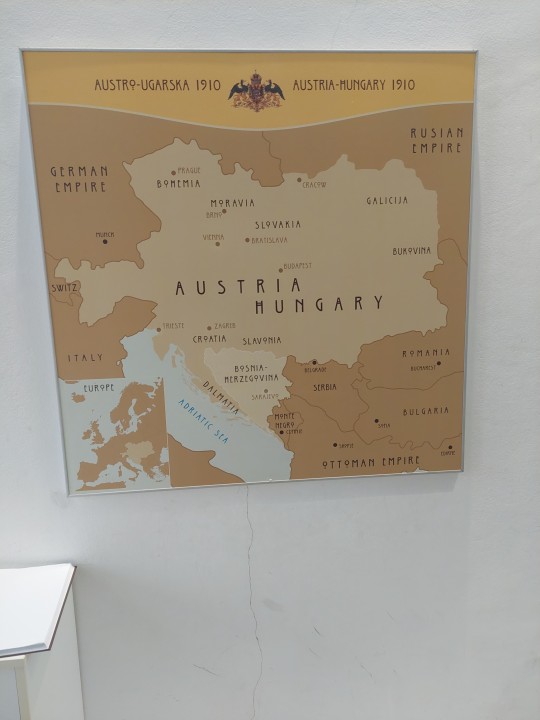
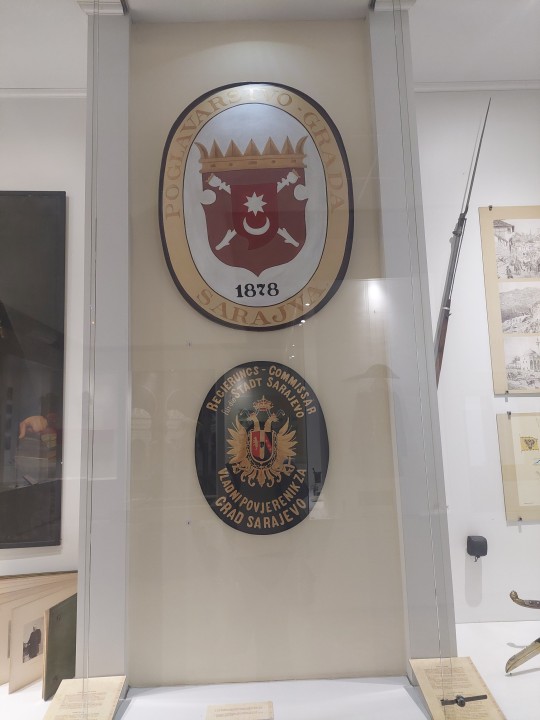
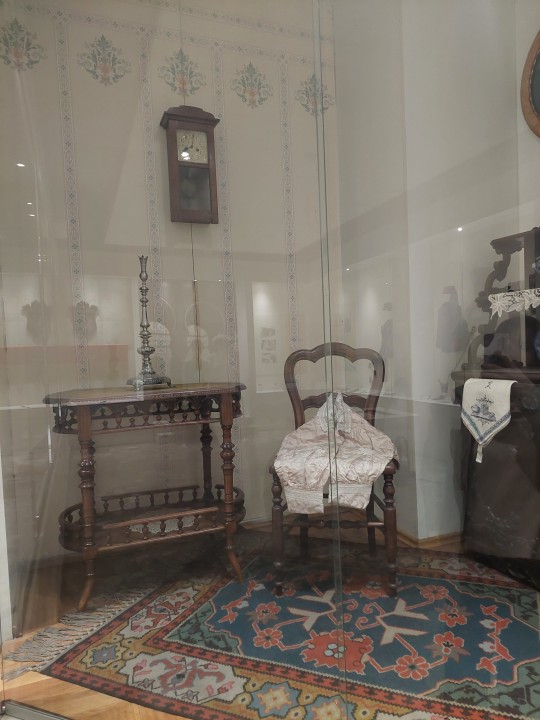

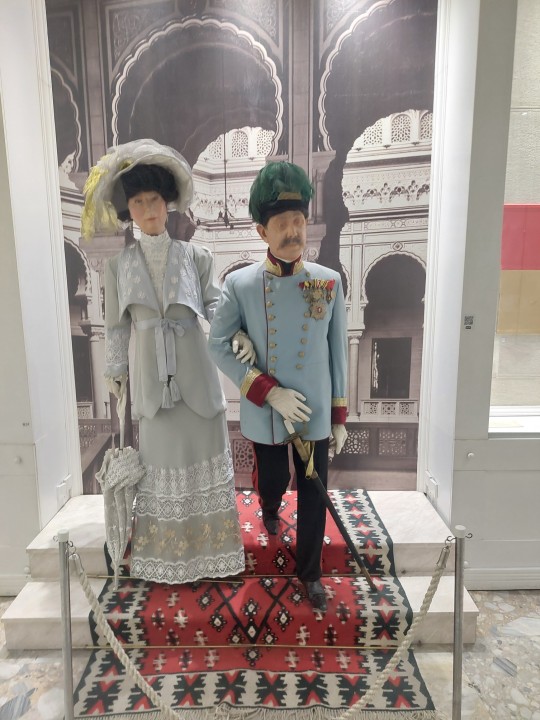


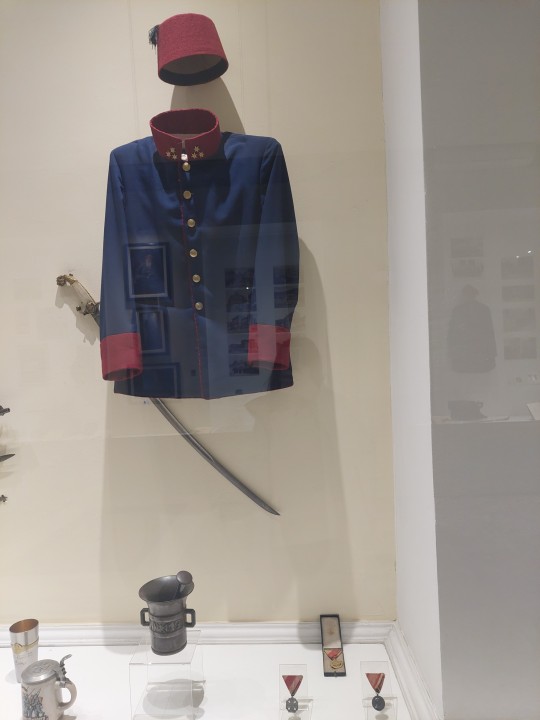


#bosnia#herzegovina#bosnia and herzegovina#history#bosna i hercegovina#sarajevo#sarajevo assassination#world war 1
10 notes
·
View notes
Text
Art Therapy in the COVID-19 Era: Inspirations Abound from Munch to Dutch Masters and Toilet Tissue
Florence Nightingale, the founder of modern nursing, said, “Variety of form and brilliancy of color in the object presented to patients are an actual means of recovery.”
We all need some #ArtTherapy in this #StayHome COVID-19 era, #AloneTogether to #FlattenTheCurve.
Yes, I’ve been spending too much time connecting on social media. Can you tell I’m in dire need of some art therapy? #Truth.
The coronavirus pandemic, like all desperate times, is inspiring amazing creativity across all media and channels. Today I’m obsessed with several art projects that delight me.
My fall-outta-my-seat art therapy moment this week came from the Getty Museum in LA. Getty challenged us to re-imagine one of the gallery’s great works of art using stuff we have at home and ourselves and/or loved ones as subjects in the compositions. Their twitter feed @GettyMuseum has the portfolio. I’ve captured a few of my favorites here, but I urge you to visit the feed and find your own faves. These are treasures of our time, illustrating individuals’ mass creativity in stressful times. Love these so much.
This program was inspired by one preceding it as the coronavirus hit Europe before the US. Creative challenges posed by The Rijksmuseum in Amsterdam and an Instagram account, Between Art and Quarantine, were precursors to the Getty program.
Next, I’m obsessed through my work-lens focusing on health consumer behavior, with the phenomenon of toilet tissue hoarding. You probably realize it’s a real thing, being discussed in both mass media and some professional publications as well. The Cottonelle brand of loo paper launched a campaign called Share A Square to promote community sharing of local toilet paper supplies, in collaboration with the United Way.
Now, two artists in Amsterdam conceived the Give-A-Sheet campaign (get it?) challenging artful folks to use one piece of toilet tissue as a canvas….literally. Here are some examples to delight you.
“We are not doctors, we are not nurses, we are not decision makers…but we are designers, so we found a way to tap into what we do best…And we hope it will help, even just a little,” the duo Guillaume Roukhomovsky and Blaz Verhnnjack told the It’s Nice That blog.
The artworks are for sale on the site, which the project recognizes that, “toilet paper has become the new safe haven currency.” The proceeds from the sales go to the World Health Organization’s COVID-Solidarity Response Fund, so there’s a lovely method behind this artful madness. Here’s a video streaming various artists’ works for the project.
More examples that move me come from street art, a natural medium for the mass, leveling consumer change caused by C19. This article in The Guardian, It feels like wartime’: how street artists are responding to coronavirus features various street artists, takes on the pandemic, including public art created in Doylestown, PA, Los Angeles, Manhattan, Miami, and Raleigh, NC.
Carrying on the toilet tissue theme, this example comes from Hijack Art who works in L.A. He told The Guardian, “This particular issue involving the coronavirus and all the devastation it’s leaving in its wake, was a no-brainer for me. The fear and call to action of this pandemic has really captured the imagination of many in and outside my city….It’s been a mixed bag of careless spring breakers, toilet paper hoarders, conspiracy theorists and hypochondria….I’m being told ‘it feels like we’re in wartime,’ so I also wanted to add that element to the piece.”
For more on art in the COVID-19 era, here’s a terrific podcast from The New Yorker.
Health Populi’s Hot Points: I close with my health economics hat on now, art therapized and feeling better for having shared these examples with you.
This last cartoon, from Robert Matson in CQ’s Roll Call, captures the stuff I’m worried about in my work-flow right here, right now: the physical/clinical and the fiscal impacts of COVID-19 in America and around the world.
In the U.S., with the largest gross domestic product on Earth in 2020, out fragmented health care system and 50-State Federalist approach has proven to land Americans in first place for steepest infection curve as of early April 2020.
With test kit and reagent shortages, ventilator un
der-supply, “free markets” for #PPE and disjointed national advice, U.S. residents are now hunkered down to #StayHome, #AloneTogether. The onus is on “Us” to flatten the curve and, as of today’s advice, wear scarf-masks to cover our faces in public.
This is our time to claim our American Health Citizenship: to own our health and healthcare system. We are now in the foxhole together in crisis mode. Once we’re past this first round of C19, and it is surely only Round 1, we have the opportunity to re-imagine and re-set our public and personal health priorities….before Round 2 hits us in the cold winter of 2020-21….
This final image comes from a couple in Serbia, from the “Between Art and Quarantine” Instagram portfolio. The original inspiration is Magritte’s “The Lovers II.” Magritte was one of the surrealist masters.
I am particularly touched by this image as today marks the 14th day of my husband’s quarantine here at home, having flown back to the U.S. two weeks ago today from Brussels. He was instructed by U.S. Homeland Security to self-quarantine once home for 14 days. Tonight, having been separate in our home for two weeks, we will sleep together in the same bed.
It’s a surreal time for all of us.
The post Art Therapy in the COVID-19 Era: Inspirations Abound from Munch to Dutch Masters and Toilet Tissue appeared first on HealthPopuli.com.
Art Therapy in the COVID-19 Era: Inspirations Abound from Munch to Dutch Masters and Toilet Tissue posted first on https://carilloncitydental.blogspot.com
0 notes
Photo

Back to the Balkans: 20 years after the Bosnian war
https://www.theguardian.com/travel/2012/apr/06/montenegro-serbia-bosnia-balkans
Liz Boulter. Friday 6 April 2012. 22.44 BST.
It is 20 years since the start of the Bosnian war, and a new tour reveals a vibrant region striving to escape its troubled past
In Ivo Andric's Nobel prize-winning novel about Bosnia, The Bridge on the Drina, a shopkeeper tells a tale of the devil, envious of the smooth, fertile land God had created, gouging its surface with his fingernails, creating the mountains and ravines that are such a feature of the Balkans. This craggy geography might well be regarded as the devil's work: for centuries it had a baleful effect on the region's history. Mountains divided it into isolated units, acting as barriers to economic, political or cultural cooperation. Conflicts, onslaughts, displacements and betrayals were a backdrop from the middle ages to the late 20th century.
Today, 20 years after the outbreak of one of the most vicious wars in the history of a region used to fighting – the 1992-95 Bosnian war – that rugged landscape is for once working in the area's favour. High peaks and plunging valleys, lakes, forests and wilderness make the region a tourist playground.
Drawn by the chance of seeing an exotic-sounding region a short flight away, my friend Kalpana and I joined one of Explore's newest tours, a Journey Through the Balkans, taking us from Croatia into Montenegro, Serbia and Bosnia-Herzegovina.
The Dubrovnik area was parched and touristy, but when we crossed into Montenegro suddenly all was green: wooded mountains, mysterious valleys and empty roads. The smallest country in the former Yugoslavia, Montenegro has more than its share of geography, including the largest lake and highest mountains on the peninsula, and the world's second-biggest gorge.
Ancient towns and wooded hillsides looked gorgeous reflected in the blue water, but we were beguiled just as much by the people. Friendly hotel staff plied us with supplies for picnics. A woman selling figs by the roadside refused to take any money. A gardener wanted to give us a pot of basil; we smilingly refused pleading air travel and he pressed dried sage on us instead.
Inland Montenegro is even more stunning, such as the sleepy town of Virpazar, with a tree-lined square overlooking the Moraca river just before it winds into vast Lake Skadar. We dined on a terrace cut into the riverbank at Konoba Badan restaurant – swallows skimming over clear water as the light faded from high green hills.
But Montenegro had more dramatic stuff in store. First the Tara Gorge – Europe's grand canyon – 78km long and 1,300m deep. Then, in the Durmitor national park, the Black Lake, Crno Jezero, so called because of the deep green of forested mountainsides reflected in water that fades to pale jade near the shore. We hiked around its perimeter, snacking on blueberries and tiny wild strawberries, bought by the cupful from another smiling local.
We were pleased to have done the hike because a highly calorific evening awaited us. Hotel MB, in the ski resort of Zabljak, is famed for its food. Bekendex andHemendex (the latter means ham and eggs – work it out) had a Two Ronnies ring, but the speciality is Karadjordjeva šnicla. This is a vast pork escalope breaded and fried then, just to make sure it is really fattening, spread with clotted cream,kajmak, and rolled up. But the highlight was a side dish of tomatoes. The Serbian/Montenegrin word for tomato is paradajz, and in this part of the world they are heavenly – tomatoes as nature meant them to taste.
As we neared Serbia we saw our first reminder of the area's Islamic heritage, a minaret poking up from a roadside village. Over the border in the town of Prijepolje, a Muslim man beckoned us over the road to proudly show us a pretty white mosque built by Ibrahim Pasha in the 16th century.
Where Montenegro was all about natural glories, Serbia's attractions were human-based, including an open-air museum where you could stay the night. Sirogojno, on the slopes of Mount Zlatibor, is a reconstructed "ethno-village" of 19th-century wooden cottages. We got to snuggle down in shuttered Hansel and Gretel houses, with traditional textiles on floors and beds, and geraniums at the windows (though we were glad of non-folkloric electricity and plumbing).
Walks into the countryside took us past rivers, forests and farms where dome-shaped haystacks were being built by hand. Everywhere was so tranquil that it was hard to believe only 20 years ago savagery on a staggering scale happened here.
Over the Bosnian border was Višegrad, the setting for Andric's novel. It looked peaceful in the sunshine, the 11 arches of its Mehmed Pasa Sokolovic bridge spanning the blue-green Drina. But its history is violent, from the bridge's beginnings in 1571 under Ottoman rulers, with saboteurs put to death horribly right on this spot, through Austro-Hungarian takeover and two world wars. Andric's book came out in 1945, but the devil was set on visiting more horror on Višegrad. In May 1992, the town was subjected to "one of the most comprehensive and ruthless campaigns of ethnic cleansing in the Bosnian conflict", with some 3,000 (Muslim) Bosniaks killed, many on this bridge, their bodies dumped in the river. Though glossed over by our (Serbian) tour leaders, it was a sobering reminder that this trip was about more than pretty countryside.
This feeling grew as we drove on towards Sarajevo, passing derelict houses that must have held sad stories. Sarajevo would want none of our pity though. From April 1992 it endured the longest siege in modern history, the death of nearly 10,000 inhabitants and damage to nearly all its buildings. But today it is a lively atmospheric city, particularly at night, with the call to prayer rolling down the hillside from the illuminated minarets of its 200 mosques, young people thronging cafes and bars, the smell of grilling cevapcici and sweetcorn on street corners.
The story of the war can be traced in the Historical Museum, the Tunnel Museum and in cemeteries overpopulated with the young. But it's just as rewarding to walk streets of churches, synagogues and mosques, browse oriental-style shops, and see the bridge where Gavrilo Princip shot Archduke Franz Ferdinand in 1914.
Many places claim to be the city where east meets west, but here is the very corner where they meet. If you stand on the main pedestrian drag, Ferhadija, and look east, you could be in Istanbul or Cairo. Turn 180 degrees and the solid Austro-Hungarian buildings feel like Vienna or Trieste.
In Andric's tale, when Allah saw what the devil had done, he sent his angels down to spread their wings over the abysses so men could cross, and so people learned how to build bridges. In tradition, one of the greatest blessings is to build a bridge, and the greatest sin to interfere with one.
The next city we visited, Mostar, became world famous for its bridges. Under Tito it was a thriving multi-ethnic city. Its lovely Ottoman-built stone bridge became a familiar image the world over in 1993 when it was destroyed by Croat shelling.
Mostar feels older than Sarajevo, and sadder. Bombed buildings mar the centre, and the city is still divided – schools, hospitals, even bus stations – between Bosniaks and Croats. But with the cool green Neretva river flowing through it, and terraces and bars along both banks, it is a lovely place to wander around. We watched a moving video in the tourist office about the reopening of the bridge in 2004, then stepped outside to see a young man leap from its apex into the water.
Bosnia looks peaceful now, but the challenges are scary: rebuilding after the war; reforming a centrally planned economy; soothing tensions inflamed by the trial (starting next month) of Bosnian Serb military leader Ratko Mladic. In this heartbreakingly beautiful country, with its engaging and resourceful people, a little prosperity and the building of a few metaphorical bridges could lead to miracles. Perhaps if Allah's angels would once more glance this way...
0 notes
